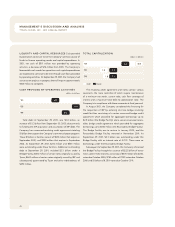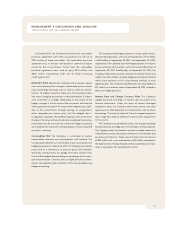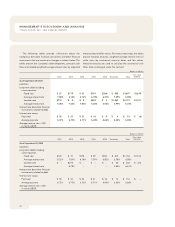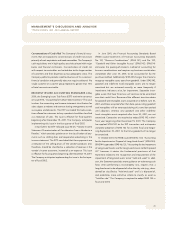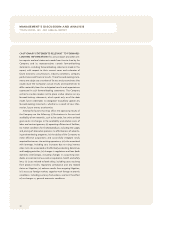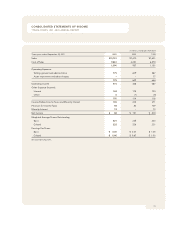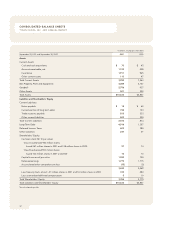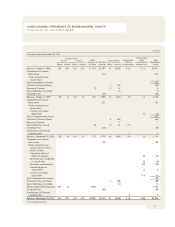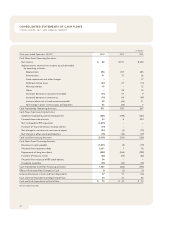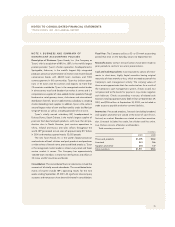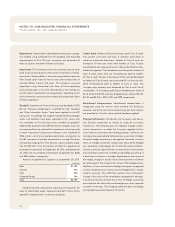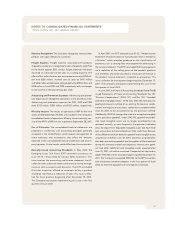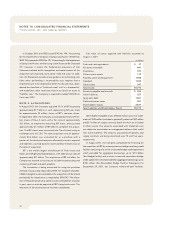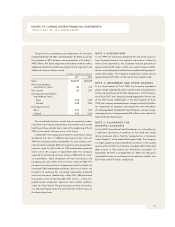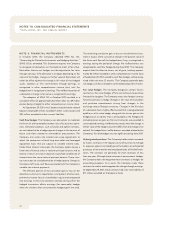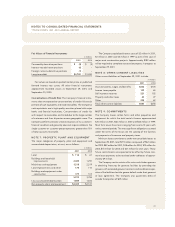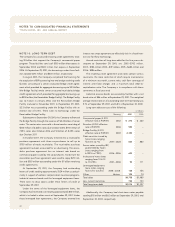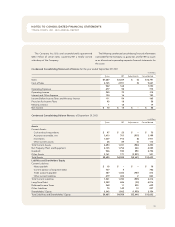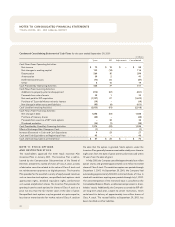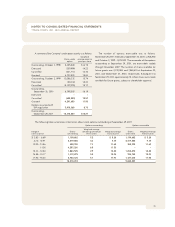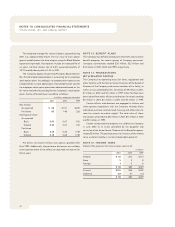Tyson Foods 2001 Annual Report Download - page 38
Download and view the complete annual report
Please find page 38 of the 2001 Tyson Foods annual report below. You can navigate through the pages in the report by either clicking on the pages listed below, or by using the keyword search tool below to find specific information within the annual report.
36
NOTES TO CONSOLIDATED FINANCIAL STATEMENTS
TYSON FOODS, INC. 2001 ANNUAL REPORT
Depreciation: Depreciation is provided primarily by the straight-
line method using estimated lives for buildings and leasehold
improvements of 10 to 39 years, machinery and equipment of
three to 12 years and other of three to 20 years.
Impairment: The Company reviews the carrying value of long-
lived assets at each balance sheet date if indication of impair-
ment exists. Recoverability is assessed using undiscounted cash
flows based upon historical results and current projections of
earnings before interest and taxes. The Company measures
impairment using discounted cash flows of future operating
results based upon a rate that corresponds to the Company’s
cost of capital. Impairments are recognized in operating results
to the extent that carrying value exceeds discounted cash flows
of future operations.
Goodwill: Statement of Financial Accounting Standards (SFAS)
No. 141, “Business Combinations” and SFAS No. 142, “Goodwill
and Other Intangible Assets” have been applied to the IBP
transaction. Accordingly, the tangible and identifiable intangible
assets and liabilities have been adjusted to fair values with
the remainder of the purchase price recorded as goodwill.
Additionally, goodwill and indefinite lived intangible assets are
not amortized but are reviewed for impairment at least annually
or more frequently if impairment indicators arise. Goodwill of
$926 million, net of accumulated amortization, arising prior to
the IBP transaction has been amortized on a straight-line basis
over periods ranging from 15 to 40 years. Upon complete adop-
tion of SFAS 142, in the first quarter of 2002, this goodwill will
no longer be amortized. At September 29, 2001, and September
30, 2000, the accumulated amortization of goodwill was $286
and $256 million, respectively.
Amount of goodwill by segment at September 29, 2001:
in millions
Beef
$1,306
Chicken
916
Pork
350
Prepared Foods
184
Total
$2,756
Goodwill has been allocated to reporting units based on fair
value of identifiable assets. Approximately $29 million of this
goodwill is deductible for income tax purposes.
Capital Stock: Holders of Class B common stock (Class B stock)
may convert such stock into Class A common stock (Class A
stock) on a share-for-share basis. Holders of Class B stock are
entitled to 10 votes per share while holders of Class A stock
are entitled to one vote per share on matters submitted to share-
holders for approval. Cash dividends cannot be paid to holders of
Class B stock unless they are simultaneously paid to holders
of Class A stock. The per share amount of the cash dividend paid
to holders of Class B stock cannot exceed 90% of the cash divi-
dend simultaneously paid to holders of Class A stock. The
Company pays quarterly cash dividends to Class A and Class B
shareholders. The Company paid Class A dividends per share of
$0.16, $0.16 and $0.115 and Class B dividends per share of $0.144,
$0.144 and $0.104 in 2001, 2000 and 1999, respectively.
Stock-Based Compensation: Stock-based compensation is
recognized using the intrinsic value method. For disclosure
purposes, pro forma net income and earnings per share impacts
are provided as if the fair value method had been applied.
Financial Instruments: Periodically, the Company uses deriva-
tive financial instruments to reduce its exposure to various
market risks. The Company does not regularly engage in spec-
ulative transactions, nor does the Company regularly hold or
issue financial instruments for trading purposes. However, the
Company does periodically hold positions as economic hedges
for which hedge accounting is not applied. Generally, contract
terms of a hedge instrument closely mirror those of the hedged
item providing a high degree of risk reduction and correlation.
Contracts that are highly effective at meeting the risk reduction
and correlation criteria are recorded using hedge accounting. If
a derivative instrument is a hedge, depending on the nature of
the hedge, changes in the fair value of the instrument will either
be offset against the change in fair value of the hedged assets,
liabilities, or firm commitments through earnings or recognized
in other comprehensive income until the hedged item is recog-
nized in earnings. The ineffective portion of an instrument’s
change in fair value will be immediately recognized in earnings.
Instruments that do not meet the criteria for hedge accounting
are marked to fair value with unrealized gains or losses reported
currently in earnings. The Company generally does not hedge
anticipated transactions beyond 12 months.


